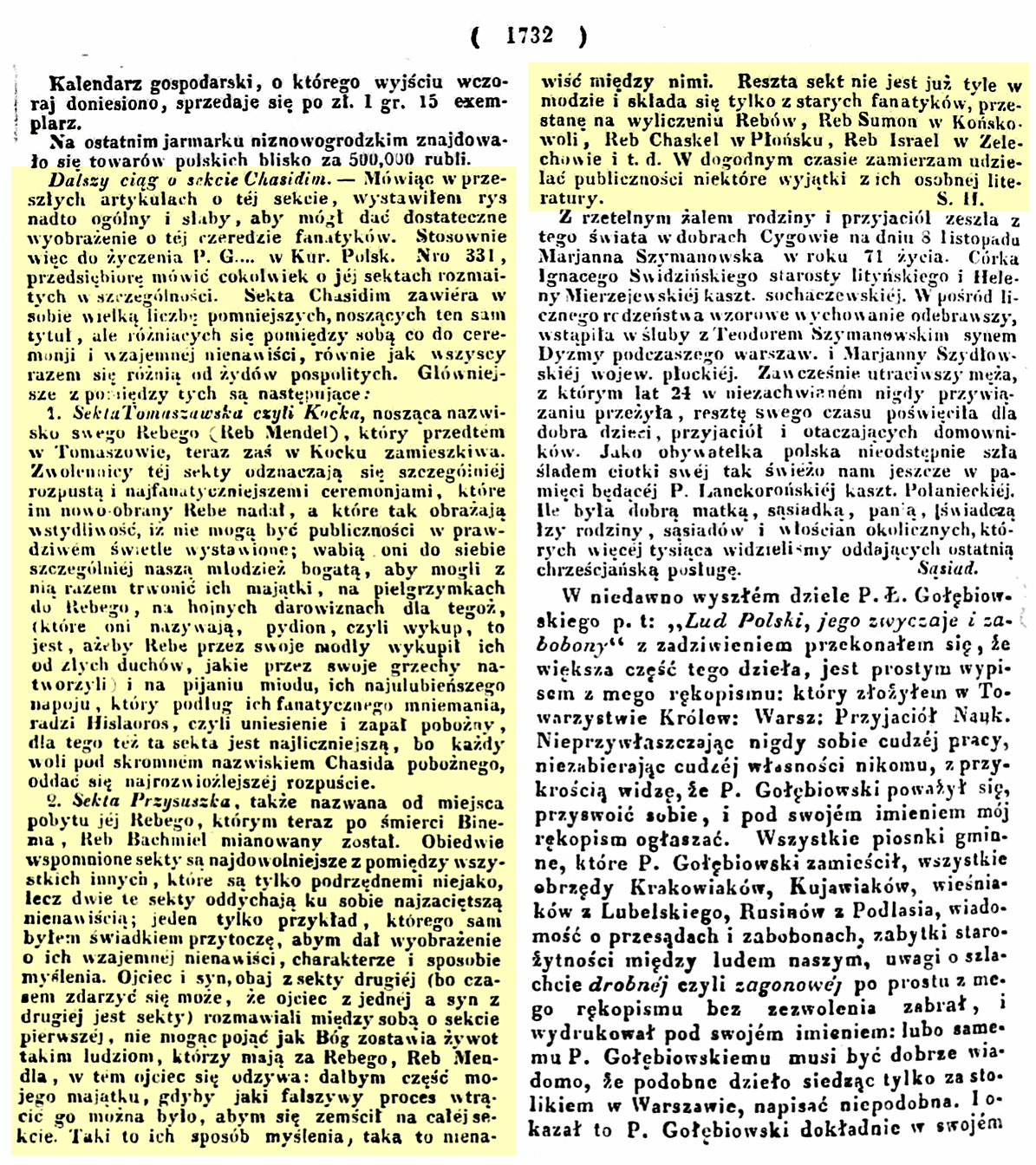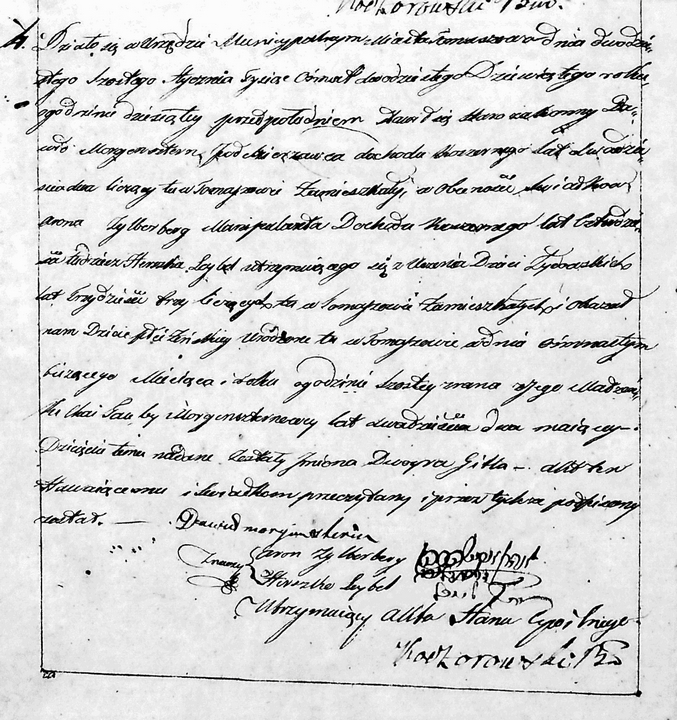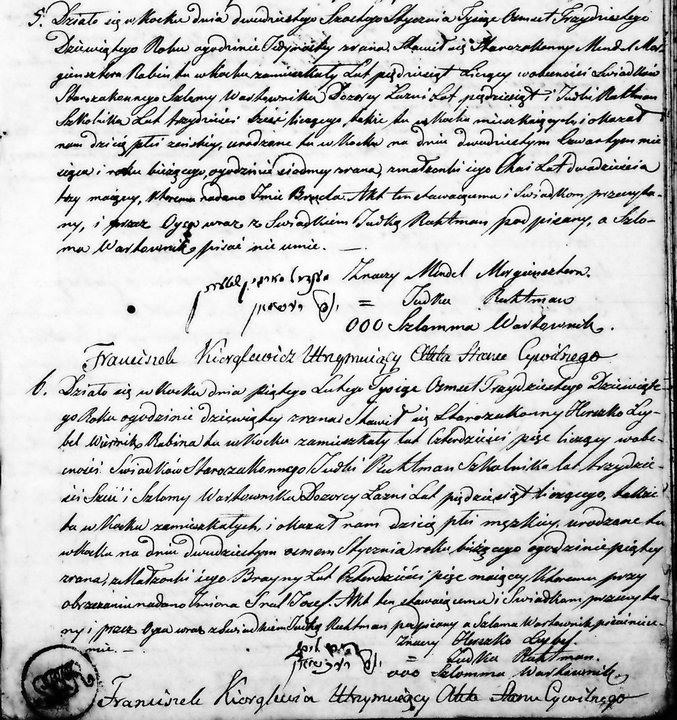MENACHEM MENDEL MORGENSZTERN
(1787-1859)
The town of Kock is famous among the Jewish community as the home of the
Rabbi Menachem Mendel Morgensztern
(the Kotzker Rebbe). Along with his teachers, Rabbi
Simcha Bunim of Peshischa
(Przysucha) and Rabbi
Jacob Isaac Horowitz of Lublin
(the Seer of Lublin), Morgensztern significantly influenced the practices of Hasidic Judaism and are fondly remembered and celebrated among many Hasidic Jews today.
Morgensztern’s Views
Bunim, Morgensztern, and others in this sect of Hasidism taught that faith is internal. Morgensztern in particular felt that the public displays of piety performed as part of then-standard Hasidic practices were done on false pretenses, that is, people who were not “good, god-fearing men” could still perform these functions and appear as such to the rest of the world.
Early Life
Menachem Mendel was born around 1787 to the Misnagdim
couple Srul Lewek Morgensztern and Elka in
Goraj, Lublin Voivodeship
. In his youth, he became attracted to Hasidism after hearing stories
of other famous Hasidic leaders and went to Lublin to study under
Yitzchak Horowicz (the 'Seer' or 'Chozeh' of
Lublin). Although he continued to respect the Seer throughout his
life, he left the Seer's court after several years to learn under
the Holy Jew of Peshischa (Yaakov Yitzchak Rabinowicz of Przysucha)
and his disciple Simcha Bunim Bonhardt.
Simcha Bunim's method of teaching seems to have had the greatest
influence on Mendel, who incorporated many of his teachings into his
own style of Hasidism.
Rabbi of Tomaszów Lubelski
Around 1807, Mendel married Glicke Naye of Tomaszów Lubelski and later
lived there for several years as a tzaddik. Conflicts arose between
Mendel and others in the Tomaszów community; one source noted that
Jews from all over Poland, primarily from impoverished towns, were
flocking to see this tzaddik and the Jews in Tomaszów didn't like
the appearance of beggars hanging around! As a result, Mendel left
Tomaszów around 1828 for Kotzk.
Several people seem to have followed him from Tomaszów to Kotzk,
specifically Hersz Leybel
, who shows up in early synagogue records in
Tomaszów and then appears in Kock. Hersz Leybel is probably the same
person as "Hersz Tomaszówer" or "Hersz of
Tomaszów" that is mentioned in several sources about
Morgensztern's life.
This record was found in the Synagogue Records for Tomaszów Lubelski maintained by the State Archives in Zamość, Reference Code 88/783/0/2.1/8: Records of Births, Marriages, and Deaths for 1829, Scan 5.
This record was found in the Synagogue Records for Kock maintained by the State Archives in Lublin, Reference Code 35/1740/0/2/19: Records of Births, Marriages, and Deaths for 1839, Scan 4.
Move to Kotzk
According to some, when Mendel arrived in Kotzk in 1828, he was
greeted with rocks being thrown at him because they did not want
Peshischa on their doorstep. In 1827, he was reportedly granted two
lots by Alexandra Meyzner D’Ansett, the owner of the Town at that
time.
Rabbi of Kotzk
It seems that the community came to accept him as their official
rabbi, though he rarely appears in available records.
Morgensztern's absence from records is probably attributable to
his opinion that a rabbi should focus on connecting to G-d and helping
members of the community achieve their own spiritual connections with
G-d, so other members of the community performed marriages and stood
as witnesses for birth, marriage, and death recordings in his place,
and occasionally are noted as a rabbi's "trustee" (wiernik) in these records.
Hasidim from all over the country began to visit Kock. In the early
years, followers of Morgensztern were described by other Jewish
communities as having strange behavior; Kotzk hasidim did not pray at
the usual times, did not dress like "Jews," and disregarded
societal norms. Morgensztern also reportedly had very high standards
and preferred to surround himself with a small group of
"elite" students, while being disdainful or dismissive to
anyone else. This resulted in a lot of conflicts with other tzaddiks
and misnagdim.
One of the earliest known recordings about Kotzk Hasidism consists of a small series of articles published in Gazeta Polska and Kurier Polski in 1830, which were not very favorable towards Kotzk or Hasidism in general:

Kurier Polski Nr. 339 – 19 Nov. 1830
Continuation about the Chasidim sect. In previous articles about this sect, I gave a general and too weak outline to give a sufficient idea of this group of fanatics. Therefore, according to the request of P. G.... in Kurier Polski No. 331, I will undertake to describe some of its various sects in particular. The Hasidim sect contains within itself a great number of smaller ones, bearing the same title, but differing from each other in ceremonial and mutual hatred, as they all differ from the common Jews. The principal among these are as follows:
1. The Tomaszów Sect, i.e. Kock, bearing the name of its Rebbe (Reb Mendel), who previously lived in Tomaszów and now lives in Kock. The followers of this sect are particularly distinguished by debauchery and the most fanatical ceremonies which the newly elected Rebbe has given them, which are so offensive to modesty that they cannot be exposed to the public in their true light; they especially attract our rich young people to their homes, so that they can spend their wealth with them, on pilgrimages to the Rebbe, on generous donations to him (which they call pydion, i.e. redemption, that is, so that the Rebbe redeems them with his prayers from evil spirits created by their sins) and drinking mead, their most favorite drink, which, according to their fanatical opinion, promotes Hislaoros , i.e. rapture and pious zeal, which is why this sect is the most numerous, for each prefers, under the humble name of Chasid the pious, to devote himself to the most dissolute debauchery.
2. The Przysucha Sect, also named after the location of its Rebbe, which now, after Binem's death, was appointed to Reb Bachmiel. The two sects mentioned are the most arbitrary among all others, all of which are inferior in a sense, but these two sects breathe the fiercest hatred towards each other; I will cite just one example, which I have witnessed, to give an idea of their mutual hatred, character and way of thinking: the father and son, both from the second sect (because sometimes it can happen that the father is from one sect and the son from the other sect) were talking to each other about the first sect, unable to understand how God leaves life to people who have Reb Mendel as their Rebbe, the father says: "I would give part of my fortune if some false trial could be brought against him, so that I could take revenge on the entire sect." This is their way of thinking, this is the hatred between them.
The rest of the sects are not so much in fashion anymore and consist only of old fanatics, I will stop at enumeration of these Rebs: Reb Sumon in Końskowola, Reb Chaskel in Płońsk, Reb Yisrael in Żelechów, etc. At a convenient time I intend to provide the public with some extracts from their separate literature.
— S.H.
Given that several Jews originally from Kock are found in later records in Przysucha and nearby villages, and that Simcha Bunim's descendents became relatives-by-marriage of Menachem Mendel Morgensztern several years after this was published, this article may have been written by someone, such as a Misnaged or perhaps someone influenced by the Haskalah , who exaggerated whatever actual events occurred with the intent of turning others away from Hasidism.
The "Friday Night Affair" and Period of Solitude
There are many variations in the retelling of what happened on a
fateful Friday night in 1839, but one commonality between them is that
after this event, Morgensztern burned all of his writings and secluded himself from his followers for
the remaining 20 years of his life.
Most retellings of the event describe a conflict between Morgensztern
and a disciple, Mordechai Yosef Leiner
, which occurred on the night of
Simchat Torah in 1839 (22 or 23 Tishrei, which was around 30 September
1839). One source indicates that Morgensztern had been exposed to
haskhalic writings that influenced him and caused doubts about the
path of Hasidim, and his argument with Leiner was a result of these
doubts. Others have denounced this telling of the events and
suggest that nothing
happened on any Friday night and that Morgensztern's "period
of solitude" was greatly exaggerated through time.
Death and Legacy
After reportedly spending 20 years in solitude, Reb Morgensztern passed away in Kock on 27 January 1859. His eldest son, David Morgensztern, succeeded Mendel as the Rabbi of Kock, formally establishing the Kotzk Hasidic Dynasty.
Kock was also frequented by several tzadikim of other Jewish communities who were followers of Kotzk Hasidism. Notable tzadikim with ties to Kock include:
- Yitzhak Meir Alter (Chiddushei HaRim; 1799-1866), who met the Kotzker Rebbe while they were studying together under Simcha Bunim. They later became brothers-in-law (their wives were sisters). "Itche Meir" was living in Warsaw and operating a Kotzker shtiebel at the time of the Kotzker Rebbe's death in 1859, and many Hasidim accepted him as the Kotzker's successor. Shortly after accepting this role, he was appointed as ABD of Góra Kalwaria , where he founded the Ger Hasidic dynasty. Gerrer Hasidism is one of the largest Hasidic sects alive today, and has helped to preserve the legacy of Kotzk.
- Mordechai Yosef Leiner (1801-1854), who grew up with Kotzker Rebbe in Tomaszów, studied with him under Simcha Bunim, and became his leading disciple in Kock until a falling out between them in 1839-1840, the details of which are not fully known. After the dispute, he left Kock and moved to Izbica , where he founded the Izhbitza-Radzin Hasidic dynasty.
- Avrohom Bornsztain (Avnei Nezer; 1838-1910), a disciple and later son-in-law of the Kotzker Rebbe, he went on to found his own Hasidic dynasty in Sochaczew .
- Yitzhak Simcha Esteraycher (Reb Itchile; c. 1824), grandson of Simcha Bunim of Przysucha, married the daughter of R. David Morgensztern in Kock.
- Shlomo Yehoshua David Guterman , second admor of Radzymin, son of R. Yaakov Aryeh Guterman, founder of the Radzymin Hasidic dynasty. He may have spent some time in Kock under Menachem Mendel in his earlier years. His daughter married a son of R. David Morgensztern in Kock.
Followers of Kotzk Hasidism went on to become influential Rebbes or even just influentual members of their own communities, including, among many others, those Jewish Communities in:
- Biała Podlaska and Łomazy
- Góra Kalwaria
- Gostinyn
- Grajewo
- Kurów
- Łask
- Łódź
- Łosice
- Łowicz
- Ostrów Mazowiecka
- Sławatycze
- Sokółka
- Sokołów Podlaski
- Sochaczew
- Staszów and Parysow
- Warsaw
- Węgrów
- Włodawa
Descendants of the Morgensztern family continued to serve as the Rabbis of Kock until the destruction of the Jewish community in World War II, when the last Rabbi of Kock, Abram Josef Morgensztern, was killed during a Nazi air raid.
A group on Geni have done extensive mapping of the genealogy of the Morgensztern family
, but I do not know how accurate this information is.

